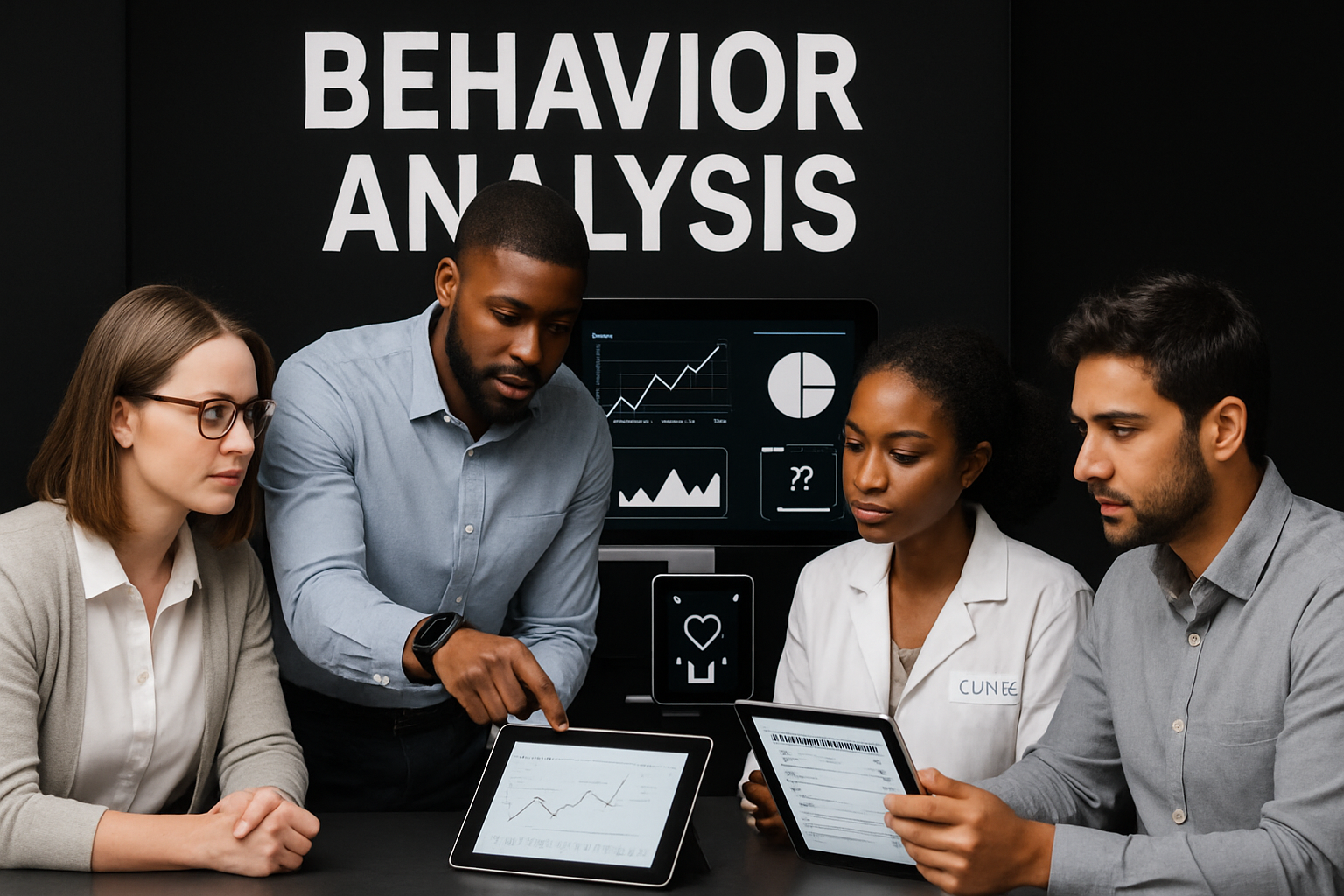The field of advanced behavioral analysis is evolving at an unprecedented pace, reshaping how professionals understand and influence human behavior. In 2025, breakthroughs in technology and methodology are driving deeper insights, enabling experts to predict actions and deliver measurable results across industries. This comprehensive guide equips you with the frameworks, tools, and strategies needed to master advanced behavioral analysis. From foundational concepts to cutting‑edge techniques, ethical considerations, and real‑world applications, you’ll gain the knowledge to stay ahead in this rapidly changing discipline.
Foundations of Advanced Behavioral Analysis
A strong grasp of the foundations is essential for professionals aiming to excel in advanced behavioral analysis. The discipline has progressed from classical theories to modern, integrated approaches that combine psychology, data science, and applied research.
Understanding these roots provides context for today’s innovations and highlights the evolution of behavioral analysis into a powerful, evidence‑based practice. By exploring foundational principles, professionals can better appreciate how advanced behavioral analysis informs decision‑making, therapy, education, and organizational success.

Evolution of Behavioral Analysis: From Classical to Contemporary Approaches
The history of behavioral analysis is rooted in the pioneering work of B.F. Skinner, whose research on operant conditioning shaped early practice. At its foundation, the discipline focused on observable behaviors and environmental influences, laying the groundwork for applied methods that remain relevant today. Over time, the field expanded to incorporate cognitive and neurobiological perspectives. This evolution allowed advanced behavioral analysis to explore not only what people do, but also how they think and why they act. Evidence‑based practice became a defining feature, ensuring that every new approach was rigorously tested and validated.
A clear example of this progression can be seen in the contrast between traditional Applied Behavior Analysis (ABA) and third‑wave therapies such as Acceptance and Commitment Therapy (ACT). While ABA emphasizes direct behavior change through reinforcement, ACT integrates mindfulness and values, reflecting the broader, more holistic scope of advanced behavioral analysis in modern practice.
| Approach | Focus | Example Techniques |
| Classical ABA | Observable behavior | Reinforcement, punishment |
| Third-Wave Therapies | Cognition & context | Mindfulness, values clarification |
Core Principles and Theoretical Models in Advanced Behavioral Analysis
At its foundation, advanced behavioral analysis integrates behavioral, cognitive‑behavioral, and contextual models. These frameworks provide essential tools for understanding how reinforcement, punishment, and functional analysis shape behavior in complex environments.
The dynamic interplay between environment, cognition, and behavior is central to modern practice. Practitioners rely on integrative models to capture the multiple factors influencing human actions. Recent studies highlight a surge in the adoption of these models across both clinical and organizational settings, underscoring their relevance in diverse applications.
For a deeper exploration of foundational concepts, see Applied Behavior Analysis Principles, which explains how techniques like positive reinforcement and functional assessment drive meaningful change across populations.
Essential Skills and Competencies for Experts in Behavioral Analysis
Excelling in advanced behavioral analysis requires a specialized blend of skills. Analytical reasoning and hypothesis testing form the backbone of expert practice, while advanced data collection and interpretation techniques ensure precision in assessment and intervention. Collaboration is equally critical. Experts must work seamlessly with multidisciplinary teams, including educators, healthcare providers, and organizational leaders. This cooperative approach ensures that behavioral insights translate into effective, real‑world strategies.
Sample Skills Matrix for Advanced Practitioners
- Analytical Reasoning: Identifying patterns and testing hypotheses.
- Data Interpretation: Using advanced tools for accurate behavioral assessment.
- Collaboration: Partnering with multidisciplinary teams for holistic solutions.
- Ethical Practice: Applying evidence‑based methods responsibly across settings.
- Adaptability: Tailoring interventions to diverse populations and environments.
| Skill Area | Description |
| Analytical Reasoning | Formulating and testing behavioral hypotheses |
| Data Interpretation | Leveraging advanced analytics and software |
| Collaboration | Integrating input from diverse professionals |
| Cultural Competence | Adapting strategies for varied backgrounds |
Continual Professional Development in Advanced Behavioral Analysis
Continual professional development is essential for experts navigating the rapidly evolving landscape of advanced behavioral analysis. Ongoing training ensures practitioners remain current with emerging research, technologies, and methodologies, enabling them to deliver effective, evidence‑based interventions across diverse settings.
Current Challenges and Opportunities in Behavioral Analysis
As advanced behavioral analysis addresses increasingly complex behavioral issues, practitioners encounter new challenges that demand nuanced approaches. Multi‑factorial problems require strategies that integrate cultural competence, inclusivity, and adaptability.
Research gaps remain, particularly in tailoring models for diverse populations and incorporating emerging technologies. Yet these challenges also present opportunities for innovation and growth. Professionals are actively exploring new methodologies and tools to meet real‑world needs more effectively.
A 2023 survey by the Behavior Analyst Certification Board (BACB) revealed that the top challenges include implementing advanced behavioral analysis in multicultural contexts and keeping pace with technological advances. By addressing these areas, the field is positioned to achieve significant progress in the years ahead.
Cutting‑Edge Techniques and Tools in 2025
The year 2025 marks a new era for advanced behavioral analysis, fueled by rapid technological innovation and a deeper understanding of human behavior. Experts now have access to sophisticated tools and frameworks that enable precise, data‑driven, and impactful interventions.
From AI‑powered analytics to advanced neurobehavioral assessments, these cutting‑edge techniques are transforming how practitioners interpret, predict, and influence behavior. The integration of technology with evidence‑based practice ensures that advanced behavioral analysis continues to evolve as a powerful discipline for both clinical and organizational applications.
Advanced Data Collection and Measurement Tools
Data collection in advanced behavioral analysis has moved far beyond traditional pen‑and‑paper methods. Today, practitioners rely on real‑time tracking through wearable technology such as smartwatches and biosensors to monitor physiological signals like heart rate and skin conductance. Digital platforms and mobile apps enable ecological momentary assessment (EMA), capturing behavior in natural environments with accuracy and immediacy.
For example, biosensors are now integrated into stress response monitoring, providing objective data to guide interventions. These innovations ensure that data in advanced behavioral analysis is not only precise but also contextually rich, supporting more effective decision‑making.
Machine Learning and Artificial Intelligence in Behavioral Analysis
Artificial intelligence is revolutionizing advanced behavioral analysis by automating complex tasks and uncovering hidden patterns. Machine learning algorithms process vast datasets to identify behavioral trends and predict future actions. AI‑driven video analysis tools can automatically code behaviors, saving time and reducing human error.
In clinical settings, AI enhances intervention planning by analyzing historical data and suggesting tailored strategies. Predictive analytics empower practitioners to anticipate challenges and personalize support. As a result, advanced behavioral analysis now leverages technology to deliver more targeted, scalable, and effective outcomes.
Neurobehavioral and Biometric Methods
Integrating neurobehavioral and biometric methods has unlocked deeper insights into advanced behavioral analysis. Tools such as EEG and fMRI allow practitioners to observe brain activity in real time, linking neural responses to specific behaviors. Eye‑tracking technology helps assess attention and engagement, particularly valuable in autism research.
By combining physiological data with behavioral observations, experts create holistic assessment frameworks. For instance, correlating heart rate variability with stress‑related behaviors enables more nuanced intervention strategies. This multi‑layered approach is reshaping how professionals understand and support complex behavioral needs.
Virtual and Augmented Reality for Behavior Modification
Virtual and augmented reality (VR/AR) are redefining how advanced behavioral analysis supports skill development and behavior change. Immersive VR environments provide safe, controlled spaces for exposure therapy, social skills training, and behavioral rehearsal. Gamification elements encourage participation and reinforce positive behaviors in engaging ways.
Recent meta‑analyses from 2024 confirm the efficacy of VR‑based interventions, particularly in reducing anxiety and improving social skills. Real‑time feedback and adaptive challenges make these interventions more effective and enjoyable, positioning VR/AR as powerful tools for modern behavioral analysis.
Advanced Functional Analysis and Assessment Protocols
Functional analysis protocols have become increasingly sophisticated in advanced behavioral analysis. Multi‑element, synthesized, and latency‑based assessments allow practitioners to pinpoint the exact function of challenging behaviors. Leveraging big data, analysts can identify behavioral patterns across large populations, enabling more strategic and scalable interventions.
In organizational behavior management, these protocols help identify environmental triggers and develop targeted solutions to improve workplace efficiency and safety. By integrating multiple data sources, advanced behavioral analysis ensures interventions are both individualized and adaptable across diverse settings.
Practical Considerations for Implementation and Scalability
Despite rapid progress, implementing advanced behavioral analysis tools presents unique challenges. Barriers include the cost of new technologies, training requirements, and ensuring data privacy. Practitioners must also adapt workflows to integrate digital tools effectively.
Surveys from 2024 indicate a steady rise in adoption rates of digital solutions among behavioral analysts, but gaps remain in access and training. Ongoing professional development and resource allocation are essential for scaling these innovations and ensuring long‑term success.
Advanced Data Collection and Measurement Tools
Data collection in advanced behavioral analysis has moved far beyond traditional pen‑and‑paper methods. Today, practitioners rely on real‑time tracking through wearable technology such as smartwatches and biosensors to monitor physiological signals like heart rate and skin conductance. Digital platforms and mobile apps enable ecological momentary assessment (EMA), capturing behavior in natural environments with accuracy and immediacy.
For example, biosensors are now integrated into stress response monitoring, providing objective data to guide interventions. These innovations ensure that data in advanced behavioral analysis is not only precise but also contextually rich, supporting more effective decision‑making.
Machine Learning and Artificial Intelligence in Behavioral Analysis
Artificial intelligence is revolutionizing advanced behavioral analysis by automating complex tasks and uncovering hidden patterns. Machine learning algorithms process vast datasets to identify behavioral trends and predict future actions. AI‑driven video analysis tools can automatically code behaviors, saving time and reducing human error.
In clinical settings, AI enhances intervention planning by analyzing historical data and suggesting tailored strategies. Predictive analytics empower practitioners to anticipate challenges and personalize support. As a result, advanced behavioral analysis now leverages technology to deliver more targeted, scalable, and effective outcomes.
Neurobehavioral and Biometric Methods
Integrating neurobehavioral and biometric methods has unlocked deeper insights into advanced behavioral analysis. Tools such as EEG and fMRI allow practitioners to observe brain activity in real time, linking neural responses to specific behaviors. Eye‑tracking technology helps assess attention and engagement, particularly valuable in autism research.
By combining physiological data with behavioral observations, experts create holistic assessment frameworks. For instance, correlating heart rate variability with stress‑related behaviors enables more nuanced intervention strategies. This multi‑layered approach is reshaping how professionals understand and support complex behavioral needs.
Virtual and Augmented Reality for Behavior Modification
Virtual and augmented reality (VR/AR) are redefining how advanced behavioral analysis supports skill development and behavior change. Immersive VR environments provide safe, controlled spaces for exposure therapy, social skills training, and behavioral rehearsal. Gamification elements encourage participation and reinforce positive behaviors in engaging ways.
Recent meta‑analyses from 2024 confirm the efficacy of VR‑based interventions, particularly in reducing anxiety and improving social skills. Real‑time feedback and adaptive challenges make these interventions more effective and enjoyable, positioning VR/AR as powerful tools for modern behavioral analysis.
Advanced Functional Analysis and Assessment Protocols
Functional analysis protocols have become increasingly sophisticated in advanced behavioral analysis. Multi‑element, synthesized, and latency‑based assessments allow practitioners to pinpoint the exact function of challenging behaviors. Leveraging big data, analysts can identify behavioral patterns across large populations, enabling more strategic and scalable interventions.
In organizational behavior management, these protocols help identify environmental triggers and develop targeted solutions to improve workplace efficiency and safety. By integrating multiple data sources, advanced behavioral analysis ensures interventions are both individualized and adaptable across diverse settings.
Practical Considerations for Implementation and Scalability
Despite rapid progress, implementing advanced behavioral analysis tools presents unique challenges. Barriers include the cost of new technologies, training requirements, and ensuring data privacy. Practitioners must also adapt workflows to integrate digital tools effectively.
Surveys from 2024 indicate a steady rise in adoption rates of digital solutions among behavioral analysts, but gaps remain in access and training. Ongoing professional development and resource allocation are essential for scaling these innovations and ensuring long‑term success.
| Challenge | Solution |
| Technology costs | Grants, shared resources |
| Training requirements | Online courses, peer mentoring |
| Data privacy | Secure platforms, updated protocols |
Integrating Advanced Behavioral Analysis in Practice
By addressing current challenges, the field of advanced behavioral analysis can maximize its impact and expand its reach. The next step is bridging the gap between theory and real‑world application.
Integrating advanced behavioral analysis into daily practice requires a strategic, stepwise approach. Professionals combine sophisticated assessment methods, data‑driven interventions, and interdisciplinary teamwork to achieve measurable outcomes. This integration ensures that behavioral insights translate into meaningful change across clinical, educational, and organizational settings.
When applied effectively, advanced behavioral analysis empowers practitioners to design interventions that are precise, scalable, and adaptable. By aligning evidence‑based strategies with practical implementation, experts can deliver results that improve individual well‑being and organizational performance alike.

Step 1 – Comprehensive Assessment and Baseline Data Collection
Every successful application of advanced behavioral analysis begins with a thorough assessment. Experts combine direct observation, self‑report measures, and informant ratings to build a complete picture of the individual’s behavior.
Capturing baseline data is critical—it establishes a reference point for measuring progress and tailoring interventions. Context matters: environmental variables such as setting, time of day, and social dynamics often influence behavior patterns.
For example, in school‑based interventions, analysts observe students across multiple contexts to identify triggers and strengths. This multi‑modal approach ensures advanced behavioral analysis addresses the full spectrum of influencing factors.
Step 2 – Hypothesis Development and Functional Analysis
Once baseline data is collected, practitioners develop testable hypotheses about the function of the target behavior. By analyzing patterns, they identify antecedents and consequences that maintain the behavior.
Selecting the right assessment tools is essential. Functional analysis protocols—such as analog or trial‑based assessments—clarify which environmental variables are most influential.
Consider a workplace safety scenario: hypothesizing that unsafe behaviors increase during shift changes allows analysts to design targeted interventions. This step ensures advanced behavioral analysis remains data‑driven and purposefully directed.
Step 3 – Data‑Driven Intervention Design
With clear hypotheses, professionals move to intervention design. Advanced behavioral analysis excels here, leveraging analytics, machine learning insights, and AI‑generated recommendations to create personalized strategies.
For instance, real‑time feedback from wearable devices can inform adjustments instantly. Continuous data integration ensures interventions remain responsive and effective. Personalized behavior modification, grounded in robust data, leads to better outcomes and stronger stakeholder engagement.
Step 4 – Implementation and Ongoing Monitoring
Implementation goes beyond launching an intervention. Advanced behavioral analysis emphasizes dynamic monitoring through mobile apps and digital dashboards. These tools track progress, identify trends, and enable timely adjustments.
Adaptive interventions are now possible. If data shows a plateau or regression, plans can shift immediately. This real‑time responsiveness is a hallmark of advanced behavioral analysis, maximizing efficiency and effectiveness.
Recent studies highlight improved outcomes when interventions are continuously tailored based on ongoing data streams.
Step 5 – Evaluation and Outcome Measurement
Evaluation demonstrates the true value of advanced behavioral analysis. Practitioners apply advanced statistical methods to analyze outcomes, ensuring interventions remain evidence‑based and transparent.
Clear reporting is essential for stakeholders—including families, educators, and funders. Analysts often use visual displays, progress graphs, and summary tables to communicate findings effectively.
Longitudinal measurement, such as tracking changes over months or years in community settings, showcases the sustained impact of advanced behavioral analysis.
Step 6 – Collaboration and Interdisciplinary Integration
Collaboration is the final step in advanced behavioral analysis. Success increases when practitioners partner with educators, healthcare professionals, and families. Integrated care plans address the individual’s needs holistically.
Research shows interdisciplinary approaches lead to higher intervention success rates. Teams coordinate efforts, share data, and develop unified strategies—ensuring advanced behavioral analysis delivers comprehensive, person‑centered results.
Building a culture of teamwork and open communication is essential for long‑term success in this evolving field.
Ethical, Legal, and Social Considerations in 2025
Navigating the ethical, legal, and social landscape is vital for practitioners of advanced behavioral analysis in 2025. With new technologies and data sources, professionals face complex challenges that demand thoughtful, informed solutions.
Issues such as data privacy, informed consent, and equitable access must be addressed to ensure responsible practice. By prioritizing ethics and inclusivity, advanced behavioral analysis can continue to expand its impact while maintaining trust and integrity.
Evolving Ethical Frameworks for Advanced Practice
As advanced behavioral analysis integrates AI, biometrics, and digital tools, ethical frameworks must adapt to new realities. Practitioners are balancing traditional codes of conduct with emerging dilemmas, such as managing dual relationships in virtual spaces and ensuring informed consent for AI‑driven assessments.
Privacy concerns are especially pressing with wearable technology. Clients may not fully understand how much personal data is being collected or shared. To address this, professionals emphasize collaboration, assent, and empowerment, ensuring that individuals remain active participants in the decision‑making process.
Ethical decision‑making in advanced behavioral analysis requires ongoing education, reflection, and transparency with all stakeholders. By evolving frameworks to meet modern challenges, practitioners can maintain trust while responsibly leveraging new technologies.
Evolving Ethical Frameworks for Advanced Practice
As advanced behavioral analysis integrates AI, biometrics, and digital tools, ethical frameworks must adapt to new realities. Practitioners are balancing traditional codes of conduct with emerging dilemmas, such as managing dual relationships in virtual spaces and ensuring informed consent for AI‑driven assessments.
Privacy concerns are especially pressing with wearable technology. Clients may not fully understand how much personal data is being collected or shared. To address this, professionals emphasize collaboration, assent, and empowerment, ensuring that individuals remain active participants in the decision‑making process.
Ethical decision‑making in advanced behavioral analysis requires ongoing education, reflection, and transparency with all stakeholders. By evolving frameworks to meet modern challenges, practitioners can maintain trust while responsibly leveraging new technologies.
Legal Regulations and Compliance in 2025
The legal landscape for advanced behavioral analysis is rapidly evolving. Practitioners must comply with national and international laws governing behavioral data, including HIPAA in the United States and GDPR in Europe. New privacy standards are emerging to address the complexities of digital and biometric data collection.
Recent legal cases underscore the risks of non‑compliance, such as unauthorized data access or sharing without consent. These examples highlight the importance of strict adherence to regulations and proactive compliance strategies.
Key Regulations to Monitor
- HIPAA (U.S.): Protects health information and governs data security in clinical contexts.
- GDPR (Europe): Ensures data privacy, consent, and transparency for individuals across EU member states.
- Emerging Standards: New global frameworks are being developed to regulate biometric and AI‑driven data use.
By staying informed and compliant, practitioners safeguard both clients and organizations, ensuring advanced behavioral analysis continues to thrive responsibly in 2025 and beyond.
| Law/Standard | Region | Focus Area |
| HIPAA | USA | Health information privacy |
| GDPR | Europe | Data protection |
| CCPA | California | Consumer privacy |
Social Justice and Cultural Sensitivity in Behavioral Analysis
Equitable access and cultural competence are foundational to advanced behavioral analysis. Interventions must be adapted for diverse populations, languages, and cultural norms to ensure meaningful outcomes.
Practitioners should actively address potential biases in assessment tools and intervention strategies. For example, modifying protocols to respect cultural traditions or family structures can make services more effective and inclusive.
Collaboration with community leaders and providing materials in multiple languages helps bridge service gaps. In this way, social justice in advanced behavioral analysis becomes not just an ideal but a daily practice.
Managing Data Security and Confidentiality
With the growing reliance on digital tools, safeguarding sensitive data is more critical than ever in advanced behavioral analysis. Practitioners face increasing cybersecurity threats, ranging from phishing to ransomware.
Best practices for data security include encrypting client data both in transit and at rest, using multi‑factor authentication across platforms, and regularly updating software and security protocols.
A 2023–2024 survey reported a rise in data breach incidents among behavioral health providers, underscoring the need for proactive risk mitigation. Protecting confidentiality is essential for maintaining trust and compliance.
Professional Boundaries and Scope of Practice
Defining roles and maintaining boundaries is vital in multidisciplinary teams applying advanced behavioral analysis. As AI and automation enter the field, new ethical dilemmas arise—such as determining responsibility for automated recommendations.
Professionals must clarify their scope of practice, especially when using AI‑generated interventions. Open communication and clear documentation prevent misunderstandings and safeguard client welfare.
Ultimately, advanced behavioral analysis requires ongoing professional development, ethical vigilance, and respect for each team member’s expertise.
Future Trends and Innovations in Behavioral Analysis
The future of advanced behavioral analysis is unfolding rapidly, with groundbreaking innovations reshaping how professionals understand and influence human behavior. As we look toward 2025, staying ahead means embracing new technologies, interdisciplinary strategies, and evolving best practices.
Predictive Analytics and Proactive Interventions
Predictive analytics is transforming advanced behavioral analysis by enabling professionals to anticipate behavioral risks before they escalate. With big data and machine learning, practitioners can identify subtle patterns and forecast potential challenges, shifting from reactive to preventive strategies.
For example, predictive modeling now allows early intervention in mental health by analyzing social media cues, wearable biometrics, and environmental factors. AI‑powered platforms streamline threat assessment and management, ensuring timely, individualized support.
Integration of Genetics and Behavioral Science
The intersection of genetics and advanced behavioral analysis is opening new doors for personalized interventions. Recent studies reveal how gene‑environment interactions influence behavioral outcomes, allowing analysts to tailor strategies based on genetic and contextual factors.
Advances in genomics make it possible to link specific genes to behavioral phenotypes, enabling more finely tuned interventions with higher efficacy. Ethical considerations remain critical to ensure genetic insights enhance evidence‑based practice without complicating care.
Expansion of Telehealth and Remote Behavioral Analysis
Telehealth is rapidly expanding access to advanced behavioral analysis, particularly for underserved and rural populations. Virtual service delivery removes geographical barriers, making high‑quality behavioral support more widely available.
Practitioners now use remote assessment tools and digital platforms to monitor intervention fidelity and client progress. This shift has improved outcomes in communities with limited in‑person services, while enabling continuous support, real‑time feedback, and flexible scheduling.
Cross‑Disciplinary Collaborations and Systems Thinking
Collaboration is key to the future of advanced behavioral analysis. By integrating insights from neuroscience, education, and public health, professionals can design systems‑level interventions with population‑wide impact.
Research initiatives from 2024 to 2025 highlight the power of cross‑disciplinary teams in tackling complex behavioral challenges. For example, combining neuroimaging with behavioral data provides deeper understanding of mechanisms driving change. Systems thinking unlocks innovative solutions that benefit individuals and entire communities alike.
Table: Examples of Cross-Disciplinary Impact
| Discipline | Contribution to Advanced Behavioral Analysis |
| Neuroscience | Brain-behavior mapping, neurofeedback |
| Education | School-wide behavioral frameworks |
| Public Health | Population-level intervention strategies |
Consumer‑Driven Behavioral Technologies
The rise of consumer‑driven technologies is reshaping advanced behavioral analysis beyond traditional clinical settings. Self‑monitoring apps, wearable devices, and direct‑to‑consumer platforms now empower individuals to track and modify their own behaviors.
These tools provide real‑time feedback, gamification, and personalized recommendations, but they also introduce new risks. Without proper oversight, unregulated digital interventions may lack evidence‑based grounding. As consumer adoption grows, behavioral analysts must advocate for quality standards and guide clients toward reliable, research‑backed technologies that align with advanced behavioral analysis principles.
The Next Generation of Behavioral Analysts
Advanced behavioral analysis is evolving—and so are its practitioners. Future analysts will need new competencies in AI, big data, and interdisciplinary teamwork. Training standards are shifting to emphasize mentorship, ongoing supervision, and continuing education.
Professional organizations forecast increased workforce demand and new areas of specialization. For those eager to stay ahead, events such as the ABAI 2025 Convention Program provide opportunities to engage with the latest research and skill development. As the field advances, the next generation of analysts will drive innovation, ensuring advanced behavioral analysis continues to deliver meaningful, measurable outcomes.
Partnering with Silveira Behavior Consultants
If you’re ready to put advanced behavioral analysis strategies into action, you’re not alone—we’re here to support you every step of the way. At Silveira Behavior Consultants, we make cutting‑edge methods work in real life, whether you’re seeking support at home, in school, or within the community.
Let’s discuss how we can personalize our evidence‑based ABA services to help you or your loved one thrive in 2025 and beyond. Have questions or want to learn more? Inquire About Services today and start the conversation with our team.





